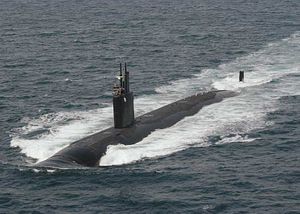The United States and South Korea are currently holding a five-day anti-submarine warfare naval exercise in the Philippine Sea in the vicinity of Guam, according to the U.S. Navy’s website.
The naval drill, codenamed “Exercise Silent Shark” and held biennially since 2011, involves one unnamed diesel-electric submarine (SSK) from the Republic of Korea Navy (RoKN), as well as one United States Navy (USN) Los Angeles-class nuclear attack submarine (SSN), and the Ticonderoga-class guided-missile cruiser USS Shiloh (CG 67).
The drill, taking place from June 8-12, also involves several maritime control and reconnaissance aircraft from the United States and the Republic of Korea, including the RoKN’s Lockheed Martin P-3 Orion and the U.S. Navy’s Boeing P-8A Poseidon, both of which can be deployed in anti-submarine warfare.
According to the U.S. Navy’s website, “Silent Shark provides an opportunity to utilize submarine vs. submarine tracking and quick reaction simulated engagement as a means to maintain stability throughout the Western Pacific region (…) The exercise will also enhance the Republic of Korean navy’s ability to recognize and exploit various tracking techniques.”
Both navies will be practicing “Snapdragon” type evasive maneuvers, IHS Jane’s Defense Weekly reports. This involves a cat-and-mouse game in which participating submarines are trying to evade detection and escape tracking from the navies’ P-3 and P-8 aircraft.
Furthermore, Silent Shark 2015 will also enable the Republic of Korea Navy, to become more familiar with the detection and emissions profile of the P-8A planes, as IHS Jane’s Defense Weekly points out. South Korea wants to slowly phase out its fleet of P-3 Orion and has shown interesting in acquiring 20 maritime patrol aircraft, with the P-8A as a potential replacement candidate.
“We are conducting this exercise as a routine training opportunity with the ROKN to further build and increase interoperability,” said Capt. Kurush F. Morris, commanding officer of the USS Shiloh. “These training exercises are essential in ensuring security and stability in the region.”
In an interview with IHS Jane’s Defense Weekly, a U.S. Navy public affairs officer noted that “executing complex ASW scenarios like those in Exercise ‘Silent Shark’ helps us practice the coordination needed with our Republic of Korea counterparts for maintaining stability in the Asia Pacific.”
As I reported before (see: “Will Corruption Undermine South Korea’s Sub Modernization Program?”) ever since the 1990s, the backbone of the ROKN’s submarine fleet has been a fleet of nine 1,200-ton Chang Bogo-class diesel-electric attack submarines – a variant of the German Type 209 Howaldtswerke-Deutsche Werft SS vessel. South Korea plans to upgrade all nine subs with air-independent propulsion and flank-array sonars over the next few years.
The ROK Navy is also in the process of acquiring nine German Type 214 — designated Son Won-II-class — diesel-electric attack submarines built under license by Hyundai Heavy Industries and Daewoo Shipbuilding & Marine Engineering in South Korea.
The four Son Won-II-class 1,800-ton ships already in service with the ROK Navy are equipped with air independent propulsion systems and, according to some reports, will also be upgraded with vertical-launch systems (VLS) for missiles. The ambitious plan is to commission five more Son Won-II-class subs by 2019, with an option of adding three more at a later stage. It seems likely that the ROKN submarine currently participating in Exercise Silent Shark 2015 is of the Son Won-II-class.

































